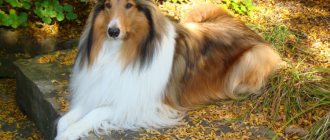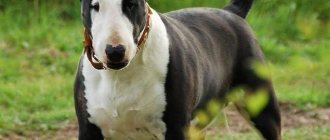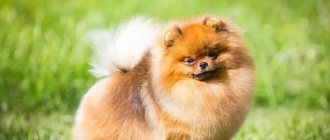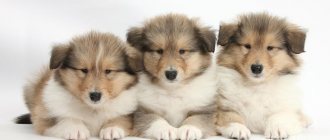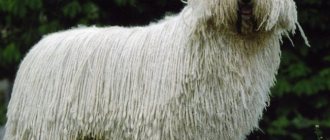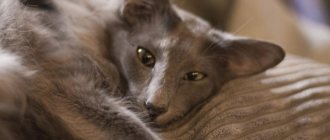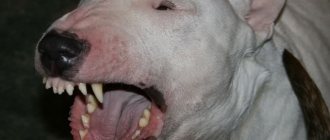Collie breed group
Collie is a group of breeds of herding and working dogs, originally from Scotland and Northern England, including officially recognized, as well as a few native breeds.
Collies are medium-sized dogs of harmonious build with an elongated head and a pointed muzzle. Active and hardy dogs, thanks to the genetically inherent herding instinct, still regularly herd livestock, but most breeds of modern collies are used as companions, guide dogs, and also show high results in various types of canine sports.
Due to their unique exterior, high personal qualities and excellent trainability, collies were widely used to develop new breeds of herding dogs, some of which have the word “collie” in their name.
Collie (Scottish Sheepdog).
Diseases
Once you have fully explored the pros and cons of the breed's personality, it is time to consider their potential health problems. Unlike some other species, the Border Collie is relatively healthy. But there are some of the most common health problems specific to this breed:
- The eye anomaly occurs in puppies and dogs under two years of age. This is an inherited disease that affects the uvea in the eye. Its role is to supply oxygen to the retina of the eye. The disease can lead to thinning of the choroid. And then, to blindness and intraocular hemorrhage. There is no cure for this problem. In mild cases, the disorder may not get worse and therefore does not require treatment. In severe cases, surgery may be required to relieve some symptoms. Discuss all treatment options with your veterinarian.
- Dysplasia of the hip and elbow joints. Hip dysplasia is an extremely common orthopedic condition in dogs. It is estimated that 70% of individuals are affected by it. Elbow dysplasia is less common but can also occur in this species. As in the previous case, elbow and hip dysplasia are genetic diseases. They can appear in animals at any age. As the joints develop, the femoral head dislocates. The joint wears down over time, causing pain, stiffness, an unusual gait, and other symptoms. Your veterinarian will help you determine a treatment plan based on the severity of your symptoms. The condition is controlled with painkillers and physical rehabilitation. Surgery may be required.
- Osteochondritis. Cartilage acts as a buffer for the joint. When the disease occurs, the cartilage in your pet's joints begins to break down. Without it, the joint becomes mobile and painful. The disease occurs in puppies from the age of four months. Contact your veterinarian and he will prescribe a treatment plan. Most often, the specialist will recommend surgery or arthroscopy (minimally invasive surgical procedure).
- Progressive retinal atrophy. This is a degenerative condition that gradually impairs your dog's vision. Ultimately, it leads to blindness. There is no cure for retinal atrophy. But you can improve your pet's condition with medications. Border collies are so intelligent that they often adapt well to vision loss. You will need to ensure that their habitat remains safe.
- Epilepsy. The main symptom of the problem is seizures. Signs of epilepsy in an animal may appear during the first six months of life. Currently, there is no screening test to detect this disease. Medications are most often used to treat epilepsy. Understanding the signs of an epileptic seizure and how to treat it is also important for proper treatment. Consult your veterinarian who will prescribe a treatment regimen.
- Hypothyroidism. With this disease, the dog's thyroid gland does not produce enough hormones. Some signs that your pet may have hypothyroidism include: dry skin, dull coat, weight gain, hair loss, aggression and behavioral changes. Diagnosis is a simple blood test. If your pet is confirmed to have hypothyroidism, your veterinarian will prescribe medication to balance the production of thyroid hormones. After this, symptoms should disappear within a few weeks. Sometimes the dosage must be changed several times. Once the correct dosage is found, have your blood tested periodically. You will be giving medications to your pet for the rest of its life.
- Dental problems are quite common in this species. The accumulation of tartar and plaque around the gum line can lead to tooth decay and tooth loss, as occurs in humans. Clean your friend's mouth regularly.
- Heart diseases. Congenital heart disease is a common genetic defect of the species. This condition usually results in congestion of blood on the left side of the heart. In severe cases, it causes heart failure and death. Symptoms: shortness of breath when walking and exercising, lethargy. Contact your veterinarian for a diagnosis.
origin of name
There is an opinion that the dogs got their name by analogy with the Scottish word “coal”, meaning “coal”. The second, more logical justification sees the word “coolley” in the name of the breed - this is how the black-headed sheep that these dogs herded were called in Scotland.
In any case, most herding dogs of Scottish origin are called “collies”, and breeds developed with them in other countries, such as North America and Australia, are called herding dogs or sheepdogs.
Border Collie.
Basic commands
You will use some commands more often, others less often. But they will still come in handy to easily interact with your border collie and even keep him safe in various situations.
- Aport. One of the most difficult teams. Many people perceive it as very easy and simple, but with many dogs you will have to work hard. This skill is used for other exercises: searching, searching, selecting an item and many others. Usually they are all used in service. When working out a command, “Aport” and “Give” are used, and a gesture is also used.
- Give. On the command “Give” the dog must give up the object.
- Lie. A connecting command that needs to be learned for other commands. In addition, it will not interfere at home or on the street.
- To me. You will need to use this command quite often. So start with it as soon as your Border Collie puppy learns his name. Never call the dog to punish, and do not scold if it comes on its own, even after mischievousness before it. This behavior on your part may alienate the animal.
- Place. A puppy or an adult dog must clearly know where his place is located. He can sleep anywhere, if you allow it, of course, but he must know this command. You can use it outside the home, marking the place with a leash or your favorite toy.
- Near. It is possible to teach your pet the “Near” command at any age, be it an adult dog or a small puppy. When you move to a new home, you should immediately think about training your puppy.
- Sit. One of the very first commands that a border collie puppy should learn.
- Stand. The command is useful in everyday life, for example, for combing a dog.
- . The prohibiting command is one of the most mandatory and taming it begins from the first day the puppy appears in the house. Requiring the command “Fu!”, “No!”, “No!” - immediately stop the unwanted action.
History of breeds
The distant ancestors of modern collies lived in England and were stocky, uniform dogs with shaggy, mostly black hair, somewhat reminiscent of border collies.
As a result of territorial conflicts, the Scots, who attacked the Britons, brought home trophies, including these same English dogs. The mixing of the blood of local Scottish breeds and imported British dogs laid the gene pool for modern collies.
In the 16th and 17th centuries, the selection of individuals was carried out solely on performance indicators. They did not pay attention to appearance and the old-type collies were very reminiscent of their shaggy and short-legged ancestors.
The beginning of the 18th century, which united England and Scotland, did not ignore the collie: breeders decided to make the dogs faster and stronger, and also significantly improved the exterior of the collie by crossing them with Irish setters and greyhounds.
Modern collies got their height and long muzzle from greyhounds. Thanks to the Irish setters, the shape of the skull was changed and the jaws were strengthened, and in some cases a pure red coat color appeared, which was subsequently not recognized as the breed standard.
Sheltie and puppies.
Border Collie puppies: choice and price
It is best to buy puppies from reputable breeders or large nurseries with a good reputation. The price of a Border Collie baby starts at $400 when purchasing a specimen without a pedigree and increases to $1000 and even $1500 if there is a particularly valuable color (brown color is more valuable) or outstanding intellectual and working abilities.
It is best to buy puppies from reputable breeders or large nurseries with a good reputation.
When choosing a pet, be sure to pay attention to general health indicators: wet nose, activity, curiosity, mobility, fatness, appetite and coat condition. If possible, hearing and vision are checked.
For an active, smart dog of the ancient herding breed Border Collie, there will always be a worthy place next to an active, intelligent, dominant person who is not alien to play, the ability to lead and the spirit of competition.
Collie popularity
Collie owes its popularization to Queen Victoria, who visited her Scottish possessions in 1860. The royal lady immediately became interested in the beautiful dogs with a balanced character and took several of them with her to England. The dogs were presented at an exhibition in Birmingham, thanks to which they received recognition and wide popularity.
At the same time, they began to pay much more attention to the appearance of dogs, relegating performance characteristics to the background. In 1867, the first long-haired sable puppy named Old Cockie was born, and since 1895, a section dedicated to long-haired collies has been firmly established in the stud books.
Interesting Facts
- Old Hemp is not the only Border Collie who has had a profound influence on the development of the breed. Whiston Cap was born in 1963 and became the most prolific collie in history. It is estimated that every Border Collie in the UK is currently descended from him. And also each individual registered with the International Sheepdog Society represents 13.3% of Wiston Cap.
- Queen Victoria was a true dog lover. In the early 1860s she became an active Border Collie enthusiast.
- The famous Scottish Poet Laureate Robert Burns was a proponent of the species. He described the breed as honest and loyal. Burns and his brother had a pet named Luat as children. But he died tragically. Burns's poem "Twa Dogs" is partly an ode to Luath. And the Burns statue in Winthrop Square in Boston depicts Luath standing eternally at his master's side.
- Animals know how and love to act in films and television shows due to their high intelligence, as well as workaholism. One of the most famous examples is the Maui pet. He played the dog Murray. The dog belonged to the main characters in the sitcom Mad About You, which aired in the 1990s. Maui played Murray for seven seasons, and was twice named the most popular dog on television by TV Guide.
- Talented border collie Striker currently holds one of the strangest Guinness World Records: "Fastest car window opening." Striker took 11.34 seconds to open a non-electric car window using its paw and nose. He set the record in September 2004 in Quebec, Canada.
- Dogs can move quickly in a cat-like, inclined position. This is due to the space between the tops of the shoulder blades, which allows them to "glide" low to the ground. This technique helps individuals herd animals with extreme precision.
- The Chaser is widely known as the smartest dog in the world. She can understand different words and also name her 1000 unique toys.
- Queen Victoria and Robert Burns are not the only famous people who owned collies. James Dean, Anna Paquin, Bon Jovi, Ethan Hawke, James Franco and Tiger Woods all had this breed.
- Films and TV series in which this breed has starred: “Snow Dogs”, “Little House on the Prairie”, “Mad About You”, “Baby”, “Year of the Dog”, “Wuthering Heights”, “Babe: The Four-Legged Baby” and many others.
- The species is also mentioned in fiction. For example, in the book “Year of the Dog. Twelve months, four dogs and me." It was written by journalist and author John Katz. He was the owner of all those dogs that, in fact, are written about in the book.
- The main work of the species is grazing. However, animals are also good at other tasks. It has to do with their mind. Collies are often used as therapy dogs. Dogs can also warn other people about deteriorating health conditions of the patient, such as seizures.
General description of collie dogs
Most representatives of the breed group are medium-sized dogs with body weight from 22 to 32 kg. Mixing the blood of long-haired and short-haired specimens, prohibited in the 70s of the last century, “stretched” the dogs on their legs, thanks to which modern collies look slender and not as wide as their ancestors.
Each breed has its own color, but the predominant colors are black, red, sable, tricolor and blue merle. The coat can be long, smooth or harsh.
Australian Shepherd
Reproduction and lifespan
In order for the breeder to receive healthy puppies, he must select for mating adult males and females who have reached the age of sexual maturity - 2 years. It is strictly not recommended to breed younger dogs.
Ideal conditions for breeding are a nursery in which both “parents” know each other well from childhood. On what day of heat is it best to breed dogs? At 3 or 4. During this period, it is important to monitor the well-being of the bitch. She should not be overly aggressive, but if her mood is difficult to call good, it is better to postpone the mating.
Pregnancy in a Border Collie lasts about 70 days. During one birth, a bitch can give birth to 10-12 puppies, but more often fewer are born, no more than 6-7. These beautiful dogs live a long time, from 14 to 16 years.
Collie character
In terms of learning ability and intellectual indicators, collies have no equal: representatives of this group occupy 4 places in the top twenty smartest dog breeds. Collies master training with ease and pleasure, and in their endless loyalty they try in every possible way to imitate their owner and take an active part in the life of the whole family.
Adult collies are classified as a protective-moderate type of dog, and despite their loyalty to people and other animals, aristocratic and friendly-looking collies will always defend their beloved owner in case of danger.
Australian Kelpie runs along the backs of sheep.
What is the difference between Collies and small Shelties? Main differences and minor ones
Dogs of the Collie (Scottish Sheepdog) and Sheltie (Shetland Sheepdog) breeds are very similar in appearance, so they are often confused, mistaking the Sheltie for a mini copy of the Collie. Or, because Shelties are smaller in size, they are sometimes mistaken for Collie puppies.
Yes, indeed, there are breeds that have mini-varieties. They differ only in size. For example, Dachshunds and Mini Dachshunds, Maltese and Mini Maltese. But this in no way applies to Sheltie and Collie. These are two different independent breeds . They differ not only in size, but also in a number of other characteristics, which we will discuss in this article.
Nutrition
This species rarely suffers from allergies, unlike other breeds. They are also less likely to have health problems, although their activity may cause joint problems later in life. In terms of nutrition, the breed is quite easy to satisfy. Individuals do not have any special needs. But, of course, there are certain ingredients that will be beneficial for dogs.
Squirrels . Like humans, animals break down protein to produce certain amino acids. They support growth, promote tissue repair and enzyme production.
Too much protein can have an adverse effect on the animal's behavior. This can make your pet hyperactive, unfocused, lack concentration, and even lead to unpredictable behavior.
If your pet walks a lot, goes for a run with you, and you regularly do daily interactive training, he will need about 22% protein.
If the dog is pregnant or sick, it is better to feed it food with a higher protein level - up to 24%.
Fats . The right kind of fat is essential to keeping your pet's skin and coat healthy. This will also give your pet an extra boost of energy.
Calcium will help maintain healthy bones and joints.
This breed is not picky and can tolerate all food components. But you should be careful about consuming too many carbohydrates. You can find them in almost all types of feed. Some feeds provide the animal with carbohydrates by 70%.
A growing individual requires 1,400 calories per day as they are more likely to be very active. For adults, 1000 calories is enough. As this breed gets older, their activity and amount of energy decreases. Therefore, older animals need about 700 calories per day.
Dogs cannot control their food intake on their own. They will eat everything you put in front of them. Divide your calorie intake into two separate meals. It's up to you to decide whether it will be breakfast and dinner or lunch and dinner.
Many dog owners, regardless of breed, choose dry food. This is due to the fact that it is more accessible. Others buy canned food.
You can also cook your pet's food yourself. But here you will have to carefully calculate the diet and calorie content of the dishes in order to provide the animals with all the necessary substances.
Difference in size and appearance
- The main, glaring difference in the photo is the size of the dogs. According to breed standards, for a Scottish Sheepdog the height at the withers should be between 51-61 cm, and for a Sheltie - 33-39 cm.
- The second important difference lies in color - three standard coat colors are acceptable for Collies, while Shelties have five.
- In addition, these dogs have different head shapes - the Scottish Sheepdog is narrower and longer at the base, while the Shetland Sheepdog is shorter and wider, and also has a more defined transition from the forehead to the muzzle.
- Compared to the Collie, the Sheltie's ears are wider at the base and set closer together, and her eyes are larger relative to the size of her head.
Kinds
Representatives of the breed are not classified by weight and height, but by coat length - yes. There are short-haired and long-haired Scottish Shepherds. Each of them is charming in its own way.
Animals from each group have 2 types of undercoat: upper and lower. The first one is much tougher than the second one. Long-haired Shepherds have a “mane” on their necks. They also have another cute feature - a bushy tail.
What is the difference between intelligence
Both of these breeds are highly intelligent dogs. They are easy to train and can learn many commands without being stubborn.
Both of these breeds are emotionally very attached to their owners and try to please them, anticipating their desires . It is not difficult for them to adapt to the lifestyle of their owner. Both Collie and Sheltie are great with children, acting as a nanny. They generally have no desire to dominate. They do not strive to show “who’s boss.” However, these intellectuals of the dog world, if necessary, are able to act independently, choosing the right decision.
Differences in Temperament
Both Scottish and Shetland Sheepdogs have a cheerful and cheerful disposition. They absolutely cannot tolerate cruel treatment or physical punishment . It is much more effective to reprimand the dog; moral punishment will work faster.
The difference is that the Collie is calmer and more reasonable. And the little Sheltie is more active and energetic. And if on the street dogs of both breeds will happily run around the lawn, then at home Collie prefers to lie quietly on the sidelines, not far from the owner. If the owner goes, for example, to another room, then Collie will first assess the situation. And if he realizes that the owner has been gone for a long time, he will move to another room after him. The Sheltie will follow on your heels. This “energizer” is in perpetual motion, the main thing for him is not to be separated from his beloved owner for a second.
Education and training
It is a common belief that smart dogs that are prone to making independent decisions do not need training. It is completely wrong. On the contrary, such animals especially need competent education!
But an inexperienced dog breeder will probably have a lot of difficulties with training a Scottish Shepherd. She is quite lazy and stubborn, so she often pretends to be weak and stupid. You can't believe this! It is important to interest the dog in learning, to instill in him a love of training. Then he will be a successful student.
How to do this? The classic way is to reward the animal for its efforts with a treat. This way he will understand that putting in a certain amount of effort entails joy from food, and therefore he will be motivated. The second piece of advice is to not allow classes to be boring. Encourage your dog with a humorous voice and an approving pat.
Advice! You are clearly raising your Border Collie incorrectly if he starts yawning after a short interaction with you. In this case, the training will have to be postponed, or try to stimulate the animal’s interest in learning.
We recommend starting to train your dog with simple commands, gradually increasing the load. This will prevent her from becoming stressed. A good training option is sports. Install low fences in the yard at a distance of 1.5 meters from each other. Each height is up to 60 cm.
Also install vertically small tubes perpendicular to the ground. First, the dog must jump over three barriers, and then run through the tubes in a serpentine line. These simple exercises increase her endurance and discipline. To prevent your dog from getting confused, put a collar on him and slowly lead him along the desired path.
He will remember it by the 3rd time and will run it correctly himself. Train your Shetland Sheepdog to be obedient in your home. She shouldn't play around and play dirty tricks. Every time she does something bad, raise your voice at her.
But, you should not hit your pet under any circumstances. Since representatives of this breed are very intelligent, they easily associate verbal reprimand from their owner with previously committed actions, and understand what they did wrong.
Care and maintenance
Initially, both of these breeds served as herding dogs. During selection, Shetland Sheepdogs lost their skills, and Collies are still in demand in some countries as sheep shepherds.
Long thick hair allows these dogs to live in the yard . In some private houses, outdoor enclosures are specially arranged for them. But most often they are kept at home, especially Shelties, since their size makes them easier to place in an apartment.
Both breeds are undemanding in care and feeding. Only their fur requires special attention. But this does not mean that they need to be combed daily, and you don’t need to bathe them often.
Description and features
The origins of the Border Collie breed are not fully understood. But, according to accurate data, it comes from Scotland, which is why it received its second name - Scottish Shepherd. Breeders believe that the Scandinavian Vikings, who often roamed the Anglo-Scottish border, should be thanked for the spread of the dog.
When the Vikings dropped anchor on the local shore, agile dogs ran away from the ships, heading to the mountain slopes. It was there that local farmers lured them. They had absolutely no understanding of dog breeds, so they crossed them with their own mongrels. Perhaps among them there were also high-breed individuals.
It was in the course of such unprofessional selection that a representative of this breed, the modern Scottish Shepherd, was born. Back in Viking times, English and Scottish farmers appreciated the amazing working qualities of the animal.
He was made into a shepherd who responsibly looked after the flock while it grazed peacefully on the lawn. In a team with a person, it regulated the movement of cattle and gently pushed the sheep that lagged behind the herd forward. If she resisted, the dog could easily squeeze her paw with his teeth, but without causing pain.
“Shepherd Dog” is not the only name for the Scottish Shepherd. She also bears the proud name of a rescuer. The character of a dog is dominated by such traits as responsibility, philanthropy and goodwill. Having heard a plea for help, human or animal, she will immediately rush to search for the poor fellow.
Rescuers in European countries still use Border Collies to this day for emergency rescue missions. She has an almost perfect sense of smell, allowing her to quickly find a person under the rubble. When he finds it, he tries to carefully pull the poor thing out on his own; if that doesn’t work, he notifies the rescuers of his location with a loud bark.
The Border Collie is known for its intelligence and energy.
The Scottish Shepherd's desire to serve people was the reason for its active use in canistherapy - psychological assistance to people suffering from neuroses and depression. The medicinal effectiveness of these animals has been proven in practice.
But that's not all. The dog is also considered a good guide dog, accompanying people with disabilities. He responsibly guides the blind, wheelchair users, and war veterans who have lost limbs.
Breeding
Small Shetland Sheepdog puppies develop much faster than Collie puppies. They finish their growth earlier, becoming adult dogs. Therefore, Sheltie bitches are ready for mating by the age of 15 months, while in Scottish Shepherds the first mating occurs no earlier than 18 months. Collies usually have 6-8 puppies in a litter (no more than 11), while Shelties usually have 4-5 puppies (no more than 7). The price for puppies of these breeds is approximately the same.
Scottish Sheepdog puppies are characterized by stable growth. With proper care, there are rarely undergrowth or overgrowth. The growth of Shetland Sheepdog puppies is unstable, and therefore there are cases when puppies grow with size deviations from the breed standard, both larger and smaller. Therefore, when selecting a pair, it is necessary to consult with breeders who have experience in breeding Shelties.
Puppies
Puppies of the species are long-legged, fluffy and very active.
Babies grow at an average rate and stop growing after about a year.
Weight and height of puppies, depending on age:
| Age, months | Height, cm | Weight, kg |
| 1 | 10-12 | 1,8-2 |
| 2 | 15-17 | 4-5 |
| 3 | 20-22 | 6-7 |
| 4 | 28-30 | 9-10 |
| 5 | 33-35 | 10-12 |
| 6 | 35-38 | 12-14 |
| 7 | 38-40 | 14-15 |
| 8 | 40-43 | 15-16 |
| 9 | 43-45 | 15-16,5 |
| 10 | 45-47 | 15,5-17 |
| 11 | 45-48 | 15-17,5 |
| 12-14 | 45-56 | 15-20 |
Their curiosity can lead them where they shouldn't. So you must remove all wires, things, and foods that your pet might chew or eat.
Don't let animals chase children, cyclists or other dogs. Early behavior modification will help control these urges.
Breeders and veterinarians have come to the conclusion that the owner can replace the animal's food with a brand of his choice. It is best to do this when your pet has been living with you for about a month. Do it gradually. Give your baby some time to adjust at first to make the transition easier. Combine about 75% old food and 25% new food in a bowl for the first day or two. On days 3 and 4, feed the animal about 50% old and 50% new food. And then, on days 5 and 6, move to a ratio of 75% new and 25% old food. Your pet should be fully adapted to the new diet by the 7th day.
Animals may become allergic to certain foods, causing their gut bacteria to be destroyed by the new diet. If the dog has not adapted to the new food, you can return to the old one. This may be indicated by refusal of food, vomiting, and diarrhea.
There are many different types of food available on the market today. So you have options to choose from! A balanced diet is very important. It affects your puppy's growth, future health and well-being.
Thus, you need to provide the animal with the necessary amount of vitamins, minerals, antioxidants, amino acids, carbohydrates, fats and other elements. Babies need additional nutrients, such as calcium. They also need about twice as many calories per 2 kg of body weight as adults.
Both dry and canned food are easily digestible. Veterinarians recommend choosing one that depends on your preferences, budget and lifestyle.
The amount fed varies depending on factors such as breed, activity and body condition.
Puppies should be fed more often than adults. Start with 4-6 meals a day. Reduce them to 2-3 small meals per day after 6 months. Start feeding your pet 1-2 times a day when he is one year old. Do not overfeed individuals! Research shows that dogs live longer and have fewer health problems if their diet is restricted early in life.

